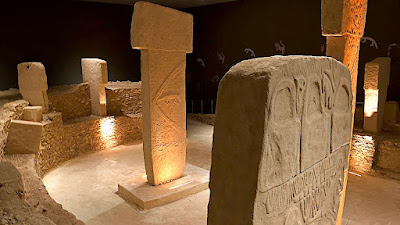The ancient temple of Göbekli Tepe in Turkey is believed to be the oldest temple ever discovered, predating even the Egyptian pyramids by over 8,000 years. Located on a hilltop in southeastern Turkey, Göbekli Tepe was first discovered by archaeologists in 1963 but was initially dismissed as a medieval cemetery. It wasn't until 1994 that German archaeologist Klaus Schmidt recognized the significance of the site and began a more thorough excavation.
The temple complex is estimated to be around 11,600 years old and was constructed by ancient hunter-gatherers before the advent of agriculture. The site is composed of several circular enclosures, each with a diameter of around 30 meters, and is believed to have been used for communal gatherings and rituals.
The structures at Göbekli Tepe are built from massive limestone pillars, some of which weigh up to 16 tons and stand over 5 meters tall. The pillars are intricately carved with images of animals such as snakes, foxes, and scorpions, as well as humanoid figures and abstract symbols.
One of the most intriguing aspects of Göbekli Tepe is the fact that it was intentionally buried around 8,000 BCE. The site was covered with soil and debris, effectively preserving it until its rediscovery thousands of years later. It is not entirely clear why the site was buried, but some theories suggest that the builders may have intentionally covered it up as part of a ritual or to protect it from invaders.
The discovery of Göbekli Tepe has challenged many long-held beliefs about the development of human civilization. The site predates the advent of agriculture and settled communities, which were previously thought to be necessary prerequisites for the construction of monumental structures like temples. The existence of such a complex and sophisticated site created by hunter-gatherers has forced archaeologists to reexamine their understanding of the capabilities of ancient peoples.
The site has also shed light on the possible origins of religion and the development of social hierarchies. The presence of such a monumental structure suggests that the builders were organized and capable of working together towards a common goal. The carvings on the pillars also suggest a rich symbolic language and a sophisticated worldview.
Despite its significance, the site of Göbekli Tepe remains shrouded in mystery. Many questions about its purpose and the people who built it remain unanswered. However, ongoing excavations and research continue to reveal new insights into one of the most important archaeological discoveries of our time.
In conclusion, the discovery of Göbekli Tepe has challenged many long-held beliefs about the development of human civilization. The site's sophistication and complexity, as well as its age, have forced archaeologists to reexamine their understanding of ancient peoples and their capabilities. The temple complex at Göbekli Tepe remains one of the most important archaeological discoveries of our time, and ongoing research is sure to reveal new insights into the origins of human civilization.



No comments:
Post a Comment